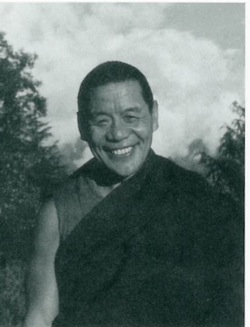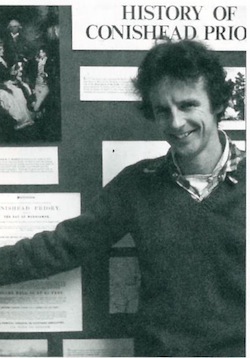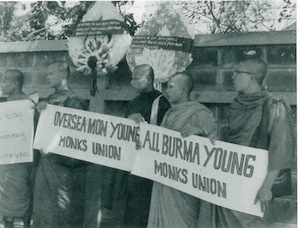Murder in Dharamsala
On February 5, 1997, three Tibetans were murdered on the campus of the Buddhist School of Dialectics, close to the Dalai Lama’s residence in McLeod Ganj, near Dharamsala, India. The victims were the founder and principal of the Institute of Buddhist Dialectics, Venerable Lobsang Gyatso, age 70, and two of his students, Lobsang Ngawang, 25, and Ngawang Latto, 23. All three were reportedly killed with sharp weapons. Lobsang Gyatso died at the scene of the crime. The two monks were rushed to a nearby hospital, where they succumbed to their injuries.
Six Tibetans were detained for investigation, and one Tibetan youth has been arrested. One newspaper,Indian Express, claims that the killer or killers are connected with followers of the deity Dorje Shugden. However, the investigation into the murders is inconclusive as of yet. Lobsang Gyatso reportedly received threatening letters that accused him of being part of the Dalai Lama “clique” and of spreading propaganda against the deity Dorje Shugden.

Worshippers of the the deity Dorje Shugden, whom they regard as a Buddha (see “In the News,” Tricycle, Fall 1996). They dispute the Tibetan spiritual leadership and the Dalai Lama’s lineage. Since 1976, the Dalai Lama has officially discouraged the worship of Dorje Shugden. Until then he too had practiced the rites and meditations connected to Dorje Shugden. He now views the deity as a divisive force that endangers both the cause for a free Tibet and also the long life of the Dalai Lama. Due to the recent murders, the Indian government has increased the number of guards protecting the Dalai Lama. This has not, however, restricted his movement, one of his spokespersons said.
Memorial services for the slain monks were held at Thechen Choeling, the main temple of His Holiness the Dalai Lama, in Dharamsala on February 15. Some 2,000 monks, nuns, and senior lamas from all traditions of Tibetan Buddhism came to pay their respects. The death of Lobsang Gyatso has been a shock and a great loss to the Tibetan Buddhist community. He was the author of many books and a renowned teacher. Born in Kham, Tibet, in 1928, and educated at Drepung Monastic University, he founded the Institute for Buddhist Dialectics in 1973 with the blessing of His Holiness the Dalai Lama. He was a strong advocate for the promotion of Tibetan nunneries and was at the forefront of helping nuns in the traditional training. Snow Lion Publications plans to publish a biography of Lobsang Gyatso’s life and work by the end of this year.
In Memoriam
Brian Beresford (1948–1997)

The Tibetan Buddhist photographer, translator, and editor Brian Beresford died in London on January 20, 1997, following a long illness. Beresford translated and edited several Tibetan Buddhist texts, including Advice from a Spiritual Friend (the first Wisdom title ever published) by Geshe Rabten and Geshe Ngawang Dhargyey. His photographs of Tibetan lamas and scenes of Tibetan culture have been published worldwide. He was also one of the first Westerners to travel into the remote areas of western Tibet, which he visited between 1986 and 1993. He intended to publish a book documenting his travels there, but that project was left unfinished at the time of his death.
Beresford was born in New Zealand in 1948. In the early 1970s he traveled through India. Between 1973 and 1979 he lived in Dharamsala and studied at the Library of Tibetan Works and Archives. He took pictures of, studied with, and translated for Geshe Rabten, Geshe Ngawang Dhargyey, Lama Yeshe, and Lama Zopa, among other Tibetan masters. In the 1980s Beresford made his home in England, where in 1985 he helped found the Meridian Trust. Based in London, this film and video archive is dedicated to the preservation of Tibetan spirituality and culture.
Beresford also translated A Meditation on Compassion by the Dalai Lama and The Dzogchen Innermost Essence Preliminary Practice by the Nyingma master Jigme Lingpa. At the end of his life, Beresford was a student of the Dzogchen master Namkhai Norbu Rinpoche. He was also a leading figure in the Dzogchen community.
The Battle for Burma
Soldiers killed at least three Buddhist monks and arrested 100 in Burma, renamed Myanmar by the current government, a group of exiled monks reported in early April. According to international human rights monitors, including the All Burma Young Monk’s Union (ABYMU), which reported the deaths, the incident was part of religious unrest that broke out in mid-March in Mandalay, Burma’s second-largest city.

What precisely sparked the unrest, and how it unfolded, remains murky. State Law and Order Restoration Council (SLORC) officials reported the violence erupted when a Buddhist girl was molested by a Muslim in Mandalay in mid-March. A later SLORC report referred to “riots between Buddhist monks and Muslims.” Witnesses quoted in the SLORC report said that several mosques were ransacked and monks staged protests in the streets. By March 21, protests had spread to other cities, including Rangoon. Witnesses there said they saw at least 100 monks detained by authorities who brought them in trucks to an unused racetrack that in the past had served as a detention center during periods of civil turmoil.
According to a statement issued by ABYMU about the alleged deaths and detentions, monks in Mandalay had planned to hold a demonstration on March 13 to protest the deaths of sixteen monks in SLORC prisons. But two days before the event, the statement asserts, SLORC officials disrupted a meeting the monks were holding and forbade the demonstration.
Amnesty International and other rights groups have documented a tangled history of persecution of monks by SLORC authorities. Reports of the desecration of monasteries and pagodas, and of torture of monks in prison, have filtered out of Burma since 1990. Monks released from prison have told of seeing stacks of hundreds of monks’ robes, evidence that many monastics had been forcibly disrobed.
Buddhist monks played key roles in pro-democracy protests between 1988 and 1990. Thousands were detained after many monks refused to perform religious rites for soldiers or their families in 1990 following military crackdowns on the democracy movement. SLORC officials have said no one was injured in the recent unrest and the organization denies reports of the deaths of imprisoned monks.
Tinseltown Tulku
Last month the Web site of Kunzang Palyul Choeling in Poolesville, Maryland, the seat of the Palyul lineage in the West, announced that actor Steven Seagal, star of such action films as Under Siege, Out for Justiceand Hard to Kill, was recognized as a tulku (reincarnate lama) by His Holiness Penor Rinpoche, the Supreme Head of the Nyingma lineage and the Eleventh Throneholder of Palyul Monastery. Khenpo Twewang Gyatso, Penor Rinpoche’s assistant, confirmed that Penor Rinpoche conducted a small ceremony in February at Namdroling Monastery in Bylakuppe, southern India, where Seagal was given a new name and recognized to be a terton, or revealer of the treasures of Padmasambhava, the founder of Tibetan Buddhism, in his previous lifetime.
The Wheel
Prajna under Par: On April 13, golf pro Tiger Woods, 21, became the youngest winner of the sixty-first Masters. Woods, whose Thai mother raised him a Buddhist, believes his faith gives him “inner peace” on the course. In addition to shooting the lowest score, he is the first man of African- or Asian-American heritage (and certainly the first of both) to win in the history of the professional golf championship. Unskillful Means: A recent cover of the conservative magazine National Review depcitedthe Clintons with stereotypical Asian features and dress and Vice President Al Gore in Buddhist robes holding a cup spouting money, to illustrate a story on Democratic fundraising in the Asian community. The cover sparked a protest by students at Yale University, who called the cover racist and offensive, and allegedly assaulted National Review editor John O’Sullivan after he made a speech on the New Haven campus. One protester was arrested. Sitting in America: A survey of spiritual matters in the United States, reported in the magazine Yes! A Journal of Positive Futures, showed that nineteen percent of Americans said they had practiced meditation; twelve percent had meditated within the previous year. The University of California at Santa Barbara has added a new endowed chair to its religious studies department: The Fourteenth Dalai Lama Chair for Tibetan Buddhism and Cultural Studies, funded in part by a donation from Tibet House New York. Scholar and translator Alan Wallace is its first occupant. Panty paramita: According to Michael Attie, onetime monk and owner of Playmates, a “lingerie temple” in Hollywood, “There’s no better place to seek enlightenment than a lingerie store like Playmates. [Your] mind is already focused on one thing—sex—so it’s a short journey to re-focus your mind on the formless heart of everything. Attend the free meditation workshops held once a week above the store and get 10 percent off on any purchase. Virtual Death: Kannonin, a temple of Shingon Buddhism in Hiroshima, Japan, is planning to open a “virtual graveyard” on the Internet. Visitors will be able to choose from different types of electronic tombstones and include photos of the deceased in a “virtual memorial.”
Thank you for subscribing to Tricycle! As a nonprofit, we depend on readers like you to keep Buddhist teachings and practices widely available.